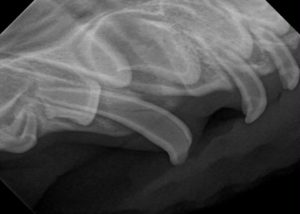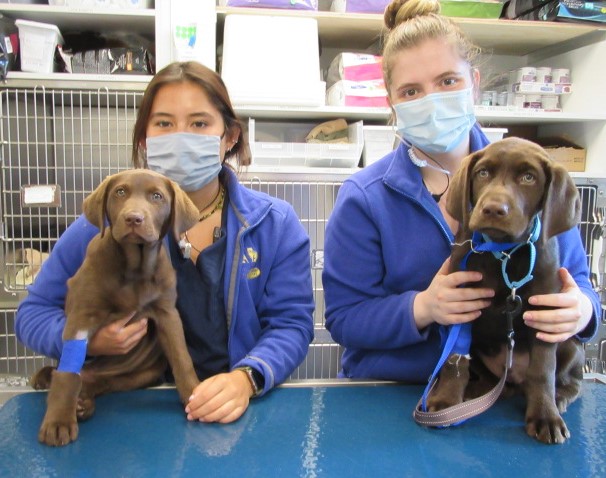
The stars of Pet of the Month for June are Rolo and Loki. These two rambunctious chocolate Labrador puppies were born in March 5 days apart, and as puppies do, they are into mischief and shenanigans. Both of them broke upper deciduous (baby) canine teeth and needed to have them extracted.
At one of Rolo’s first puppy visits, his owners described him as being a ‘land shark’ as he was getting into everything and chewing on items in the house. Dr. Robin Riedinger discussed normal puppy behavior and trying to ensure that he had puppy appropriate items to chew on. However, puppies explore their world by picking up items, and let’s be honest, some of what they get into is fun and or tasty! It can be challenging to monitor them and it takes lots of practice to teach them what is off limits. Late in May the family noticed that Rolo had broken his upper left canine tooth.
Loki was first seen by Dr. Adrian Nevill at Hawthorne Hills Veterinary Hospital when he was just about 11 weeks of age. During the exam she noticed Loki had already broken an upper canine tooth. His owner mentioned that he like eating rocks in the back yard and she thought the tooth broke a week before. Besides, being too hard to chew on, rocks present a much bigger concern if they are swallowed as some will get trapped in the intestinal tract and lead to obstructions requiring surgery to remove.
Teeth can be damaged, worn, cracked or broken in a variety of ways. Dental specialists advise that anything harder than what you can indent with your fingernail is too hard for your dog to be chewing on. That means rocks, cow hooves, bones, antlers, patio furniture and hard dog chew toys among others, can be problematic. The fact is, a lot of dogs, especially young puppies enjoy chewing on those items and certainly don’t take into consideration the risks of breaking a tooth! Teeth can also be damaged during rough play with another dog, catching a hard object/ball in their mouth, and different types of blunt force injuries.

This radiograph has yellow outline around the broken ‘baby’ tooth and the blue outlines around the developing adult teeth just below the gumline.
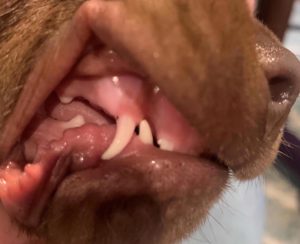
This picture shows what a normal upper deciduous ‘baby’ canine tooth should look like.
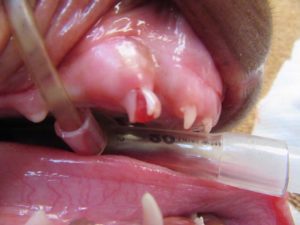
This picture shows the fracture of the tooth with the pulp canal exposed. This is painful and the tooth needs to be extracted.
If a tooth is broken, does it always need to be extracted? Depends. Veterinarians take into consideration a number of factors – which tooth, where is the damage on the tooth, is the pulp exposed, is there risk for infection, can the tooth be repaired with a root canal procedure? A small chip at the end of the tooth crown might pose cosmetic issues for a person, but that type of injury may not be an issue for a dog. However, anytime the pulp cavity, the internal structure of the tooth, is exposed, the tooth either needs to be repaired or extracted. This type of injury is very painful and will eventually lead to infection up in the bone.
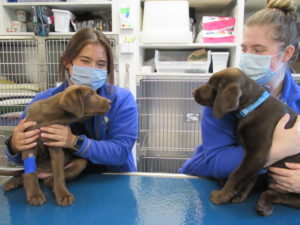
Rolo and Loki comparing notes after their procedures. They were both awake and enjoyed an afternoon snack before going home.
Dental radiographs are needed to determine the best treatment plan. Age also can be a factor in deciding what to do; in puppies, they will be losing their deciduous teeth. So sometimes, if the injury is close to the time that the baby tooth is going to be shed normally (adult canine teeth come in about 5-6 months of age), then we might wait for the baby tooth to fall out normally. However, for Loki & Rolo, because their damaged teeth had open pulp canals and because of their young age, we elected to proceed with extractions.
In early June, both Loki & Rolo came in on the same day for their procedures. Surprisingly, Rolo had broken his other upper canine tooth so he had two teeth extracted that day! Both puppies did well with their anesthesia and recovered quickly. Extracting the damaged teeth removed a source of pain, potential infection affecting the developing adult teeth and ensured they were back able to lead happy puppy lives.
Links:
Safe Toys for Puppies: https://veterinarypartner.vin.com/default.aspx?pid=19239&id=10282231
Dental Care & What to Expect: https://veterinarypartner.vin.com/default.aspx?pid=19239&id=4951294
Fractured Teeth & Treatment: https://www.dentistvet.com/tooth-breaks-and-fractures.html
Retained Baby Teeth Need Extraction: https://veterinarypartner.vin.com/default.aspx?pid=19239&id=4952450





